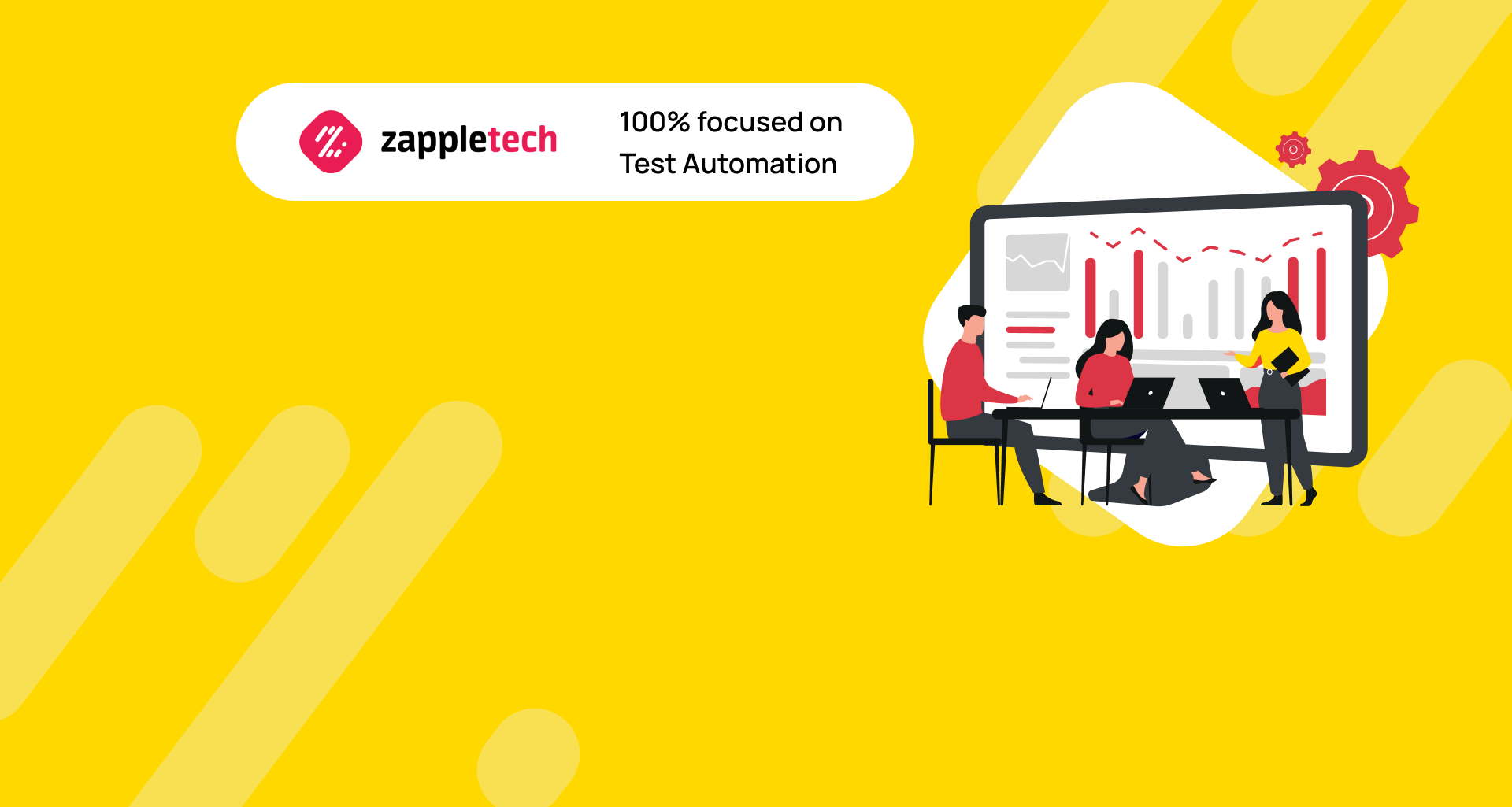According to GMInsight, the test automation market will reach $40 billion by 2027, and its CAGR level will exceed 16%. Such popularity of QA services is caused by rapid growth in demand for the development of IT products among business representatives. The Gartner report says that expenses on digital transformation (mostly on corporate software and IT services) increased by 10.8% and 9%, respectively, in 2021. Regardless of who develops an IT product, outsourcing company or full-time team, quality assurance is still one of the main priorities. That’s why QA experts are now in demand more than ever.
Checking resources for bugs is the best way to release an MVP timely and win consumer loyalty. A mandatory component of modern IT solutions is software running in the cloud. API testing is a complex yet exciting task, and the performance of the entire product often depends on its quality.
What is API automation? It’s a set of operations and techniques used to test apps’ logic and performance. Optimized automation of these processes means the possibility to create and run test scripts in particular cases and in a stream when deploying new versions of an IT product.
ZappleTech experts have prepared a detailed guide on this topic. Now you will learn about API test automation, its varieties, and how to automate the testing of API elements.
Before diving into automation, make sure you understand what APIs are and how they work. Knowing how requests and responses function will help you design better tests.Sergey AlmyashevCOO, ZappleTech Inc.
Table of Contents
Why and when is this kind of testing used?
Modern IT products support uninterrupted data exchange with the server. API allows connecting payment systems and search resources. It also integrates social services, navigation, and more. Each customer of an IT product strives to provide users with a stable connection, high response speed, and quality information processing. Unlike other program components, API affects the interface partially and performs all the basic operations invisibly. Data processing takes place on the server, so the stability and speed of the exchange are vital here.
QA experts use API automation tools to speed up verification, provide reporting, and identify problems with connectivity, processing logic, and issuance relevancy. The verification methodology is somewhat reminiscent of the “White Box,” when the input and expected results are already known.
It is assumed that the API is not a separate system component, but it is fully integrated into it. It allows early testing, maintained as each new release is deployed. Contrary to popular belief, testers do not directly interact with the code but send requests to API endpoints.
Subspecies
In contrast to the classic kind, where developers detect bugs on their own, API testing is performed by QA specialists, allowing for a more thorough and objective evaluation of the software’s functionality. API test automation plays a crucial role in this process, as it enables QA teams to efficiently validate the APIs’ performance, security, and reliability without the manual effort. There are five kinds of API testing in total, each serving distinct purposes:
- Functional Testing: This type ensures that the API functions as expected, checking the correct responses for different inputs.
- Performance Testing: This evaluates the API’s responsiveness, speed, and stability under various loads.
- Security Testing: This kind focuses on identifying vulnerabilities within the API, ensuring data protection and compliance with security standards.
- Load Testing: This subspecies assesses how the API handles heavy loads and simultaneous requests, ensuring stability under peak conditions.
- Validation Testing: This type checks the accuracy of the API’s output against the specifications, ensuring the data integrity and proper response formatting.
By incorporating API test automation into the testing process, QA specialists can perform these tests more efficiently, increasing the coverage and reliability of the API without the repetitive manual effort, ultimately leading to a higher quality product.
Unit testing
Fully automated testing involves running scripts automatically after a new version of the product is deployed. This approach ensures that the application is thoroughly tested without manual intervention, making the process more efficient and reliable. The coverage of these tests depends directly on the number of implemented functions and the variety of data sets used. The primary goal of fully automated testing is to identify even the slightest inconsistencies in the information exchange process, which is crucial for maintaining the integrity and performance of the software.
Unit testing plays a pivotal role in API test automation, as it is the foundational type of testing that often determines which subsequent tests will be executed. By breaking down the application into its smallest parts, unit tests ensure that each function works as intended. This method is essential in the API test automation process, as it helps catch issues early, preventing more significant problems from arising in later stages of testing. The effectiveness of unit testing directly influences the overall quality of the API and the smooth integration of various components.
Integration testing
Integration testing ensures seamless and fast data exchange between all application components, playing a critical role in the overall system’s functionality. Any delays or deviations in data flow can raise concerns and demand close attention from testers. To address these issues, developers utilize integration testing to debug the system, making sure it operates as a single, cohesive unit. This process is vital for verifying the compatibility of all parts, ensuring that they interact correctly without issues.
Moreover, when combined with API test automation, integration testing becomes even more efficient. API test automation allows for continuous validation of endpoints and data flows, further enhancing the integration process. This approach not only saves time but also increases the accuracy of testing by automating repetitive tasks, allowing testers to focus on more complex scenarios that could impact the overall performance of the application.
Negative testing
Negative testing is a critical aspect of software testing that focuses on identifying how a system behaves under invalid or unexpected conditions. This method is particularly important in API test automation, as it involves deliberately inputting incorrect or malformed data into the API to observe the system’s response. Users often make mistakes, such as entering invalid data, confusing language layouts, or not following the logical flow of actions. Negative testing helps ensure that the API can handle such scenarios gracefully, maintaining the overall stability and security of the system.
During API test automation, negative testing is employed to validate the robustness of the system. Testers assess the system’s response to erroneous actions by inputting invalid values, such as incorrect data types, missing fields, or out-of-range values, into the API. They then compare the actual response against the expected outcome, which is typically a defined error message or a specific error code. This process allows experts to evaluate the system’s resilience and ensure that it does not crash or behave unpredictably when faced with invalid inputs. By incorporating negative testing into API test automation, teams can enhance the reliability and security of their applications, ultimately providing a better user experience.
There are many tools available for API test automation, like Postman, SoapUI, and RestAssured. Choose one that fits your needs, is easy to use, and integrates well with your existing tech stack.Mikhail BodnarchukCDO, ZappleTech Inc.
Performance testing
Performance testing is a crucial component of ensuring that APIs can handle high loads and maintain stability under stress. API test automation plays a significant role in this process by allowing testers to emulate hundreds or even thousands of simultaneous requests to assess the system’s stress resistance. Through API test automation, testers can gradually increase the load on the system, identifying the critical threshold at which the system begins to degrade or fail, and observing how the application responds under such conditions.
API test automation not only facilitates performance testing but also extends to reliability testing, where the system’s ability to consistently perform under expected conditions is evaluated. Although performance and reliability testing often overlap, their purposes can slightly differ. For instance, while performance testing focuses on the system’s capacity to handle high volumes of traffic without crashing, reliability testing examines the system’s continuous and stable operation over time. An example of reliability testing might involve repeatedly logging in every 10-30 minutes using the same account to ensure that the API maintains session integrity and performs consistently over extended periods.
By incorporating API test automation into both performance and reliability testing, teams can efficiently identify bottlenecks, optimize performance, and ensure that their applications remain reliable under varying levels of load and over extended durations. This holistic approach to testing with API test automation not only improves system robustness but also enhances the overall user experience by minimizing downtime and performance issues.
Security testing
Security testing is essential because the API acts as the app’s shield and first line of defense. Ensuring this protection is flawless is crucial, as vulnerabilities can expose sensitive data and compromise system integrity. When the system is under heavy load, the likelihood of penetration increases, and the most effective immediate response might be to shut down the system completely and restart it. However, this approach isn’t always feasible, especially for businesses that rely on constant uptime.
API test automation plays a significant role in enhancing security testing by allowing repetitive and thorough testing of entry points, gray APIs, and potential vulnerabilities such as external spam. Experienced testers often conduct these tests because they involve complex scenarios that beginners may find challenging. Despite the critical importance of security testing, some customers mistakenly view it as an unnecessary expense, driven by a misconception about its demand or value. This oversight can lead to severe consequences, as leaving APIs unchecked exposes the application to various security risks. Integrating API test automation not only streamlines the testing process but also ensures that security measures are consistently applied, minimizing potential threats.
Random tests
Each API is built in a different format and amount of data, making testing a crucial step in the development process. A critical aspect of API test automation is handling unexpected scenarios, such as when an unauthorized package is sent to an API. There are three possible outcomes in this situation: the API might incorrectly accept the package, refuse to process it, or even crash. If the API accepts the unauthorized package, this indicates a significant vulnerability that requires immediate attention. In this case, it’s essential to delve deeper into the component to ensure it responds correctly under such conditions.
Random tests, which are often a part of API test automation, don’t follow a specific methodology or have a defined time frame. They can be used alongside other testing methods or on their own, depending on the tester’s approach and objectives. By integrating API test automation, testers can more efficiently identify and address potential weaknesses in API behavior, ultimately leading to more robust and secure applications.
Compliance tests
Compliance tests are indeed a crucial part of API test automation, ensuring that the application adheres to specified standards and requirements. This method involves verifying the application’s logic, processing user feedback, and rigorously testing “socialized” scripts to ensure they behave as expected under various conditions. As a specialized form of acceptance testing, compliance tests focus specifically on APIs and their interactions with data, validating that the API responses meet the required protocols and formats. This approach is essential for maintaining the reliability and integrity of API interactions, which is a core aspect of API test automation. By implementing compliance tests, developers can identify and address discrepancies early in the development cycle, ultimately enhancing the overall quality and performance of the application.
How to automate API testing?
There are dozens of unique and practical API test tools, but most do not support automation and parallelization. This list contains API automation tools proven by ZappleTech. Regardless of the payment model, they are market leaders used by thousands of testers worldwide. Let’s meet these heroes!
JMeter
JMeter is one of the top solutions for API test automation, offering a robust platform for testing both static and dynamic web resources as well as browser applications. It is particularly effective in handling complex products, allowing users to test entire systems or individual components with ease. JMeter’s flexibility extends to script creation, enabling testers to write, edit, and manage scripts in a user-friendly environment.

The tool excels in analyzing results autonomously, using built-in algorithms that focus on identifying cyclical errors, which enhances the accuracy and efficiency of testing. Additionally, JMeter supports various protocols, including HTTP, HTTPS, SOAP, REST, FTP, and more, making it a versatile choice for API test automation across different types of web applications. This versatility, combined with its ability to simulate a heavy load on servers, helps in performance testing, ensuring applications can handle real-world traffic conditions effectively.
SoapUI
SoapUI is a universal API automation tool and one of the most popular assistants for QA specialists, especially when it comes to API test automation. It offers a robust platform for testing APIs, allowing for flexible configurations that execute test scripts seamlessly in both local and cloud environments. SoapUI’s compatibility with a wide range of APIs, including REST, SOAP, and GraphQL, makes it a versatile choice for teams aiming to ensure comprehensive test coverage.
One of the standout features of SoapUI is its complete integration with tools for Agile and DevOps, which streamlines the testing process and enhances collaboration among development teams. This capability is particularly valuable in environments where continuous testing and integration are critical to the development cycle. Its ease of use, combined with powerful scripting capabilities and extensive support for data-driven testing, makes SoapUI a favorite among advanced development teams looking to enhance their API test automation processes.
Its features:
- Full cycle automation support.
- CI/CD integration in full package version.
- Flexible system for creating scripts and complex tests.
- Convenient forms and readable reporting formats.
- Emulation of APIs and protocols.
- Flexible pricing model.
Don’t mind the paid distribution model because the tool costs the price. You need some training and experience to use it, but enthusiasm will help you to master SoapUI quickly.
Postman
If you’re looking for a full-fledged platform for API automation tools, Postman is a top choice. This robust solution includes advanced features that support API test automation, making it ideal for teams aiming to streamline their testing processes. With Postman, you can automate testing across all sprints, ensuring the stability and reliability of your APIs. The platform’s centralized storage system allows quick and convenient access to documents, scripts, and reports, which significantly enhances collaboration among team members. Additionally, Postman’s user-friendly interface and integration capabilities make it a preferred option for both beginners and experienced developers in the realm of API test automation.
Key features of Postman:
- Analytical tools for reporting and planning.
- Workspace system: personal, shared, or team mode.
- Complete CI/CD integration out-of-the-box.
- Flexible pricing model.
- Open API repository.
- Large community and reliable technical support.
Postman is one of the central players in the QA market. Flexible and reliable features make this product a leader among API testing software.
Let’s summarize
Now you know what API test automation is. This approach ensures that your application’s backend components function as expected, improving the overall reliability and performance of your software. Since it’s a serious and responsible process, the performance and viability of your MVP depend heavily on the quality of the testing services employed. API test automation helps identify issues early in the development cycle, saving time and resources while enhancing the product’s quality.
That’s why you should not delegate QA tasks to beginners or freelancers. Only experts with extensive experience and skills can solve your task as quickly and efficiently as possible. By ordering ZappleTech services, you can ensure that your IT product is released on time without bugs, providing a seamless experience for your users.






